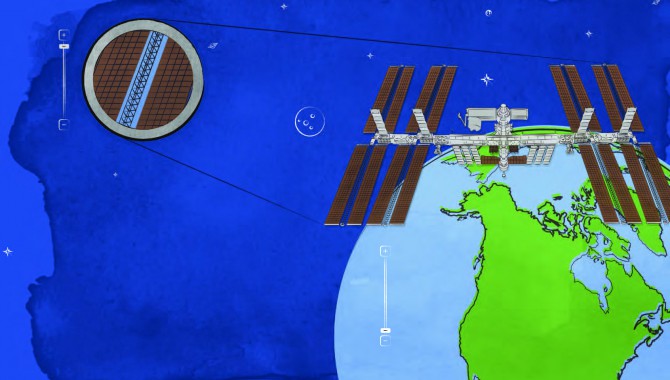
By Danielle Wood, Heidi Davidz, Donna Rhodes, and Maria So
How do NASA’s systems engineers develop the skills they need to think effectively about the complex systems they develop? How do people outside formal systems-engineering roles improve their ability to see connections across subsystem and organizational boundaries? What can NASA management do to facilitate the development of systems thinkers in its workforce? A collaboration between NASA and a university research group addressed these challenging questions.
The questions were tackled as part of the doctoral dissertation of Heidi Davidz while she was a PhD student in the Engineering Systems Division at the Massachusetts Institute of Technology (MIT). Working under Professor Deborah Nightingale, Dr. Donna Rhodes, and other faculty, Davidz devised interview and analysis methods that approach the issue both qualitatively and quantitatively. She interviewed 205 engineers at ten organizations, primarily in the aerospace industry.
Another MIT student, Danielle Wood, used Davidz’s methods to explore the development of systems thinking among engineers at NASA’s Goddard Space Flight Center. Wood’s project was part of a collaboration between Maria So (then chief of the Mission Systems Engineering Branch) and Dr. Rhodes of MIT’s Lean Advancement initiative and Systems Engineering Advancement research initiative. As a branch chief and line manager for about fifty senior system engineers at the time, So’s responsibilities included caring for the professional development of Goddard’s core systems professionals. She was also involved in several NASA activities aimed at improving systems engineering methods, including participating in the NASA Systems Engineering Working Group, shaping a NASA systems-engineering leadership development program, and updating the NASA Systems Engineering Handbook.
So and Rhodes invited Wood to carry out data collection and analysis for a systems-thinking study at Goddard based on the work of Davidz. In early 2007, Wood interviewed thirty-seven Goddard employees in four categories: senior systems engineers, junior systems engineers, senior technical specialists, and expert panelists. The expert panelists were senior leaders in the systems engineering community at Goddard. The core interview questions asked participants to define systems thinking and name enablers or barriers to the development of systems thinking in engineers. The results show that at Goddard, as in other parts of the aerospace industry, the key enablers of systems-thinking development are experiential learning, personal characteristics, and environmental effects.
Experiential Learning
Davidz’s doctoral study emphasized the importance of experiential learning in developing systems thinking. Interviewees from Goddard and the broader industry study cited valuable learning from both work and general life experience. A relatively high percentage of respondents (30 percent) at Goddard said that exposure to systems thinking and to the relationships between subsystems helped develop systems thinking. Specifically, they mentioned the opportunity to see other capable engineers successfully implementing systems engineering tasks. As one respondent said, “I got to work on projects where I had senior engineers who were willing to teach and who modeled the behavior that I needed to learn.”
One supervisor modeled systems thinking for his team when testing and qualifying equipment. As one interviewee recalled, “He always asked about how their work would affect the whole mission.” About 21 percent mentioned that it is valuable to experience a variety of roles. At Goddard, this often means rotating to various subsystems within a satellite mission team. One engineer was thankful for experience in design, testing, and project management—even when the role did not suit him.
He noted, “I tried design and realized I was not a designer.” Sometimes a team leader helped engineers find new roles that were opportunities for learning. One engineer reported that her mentor “basically fired [her] off the Hubble Space Telescope project so [she] would get some experience.” She eventually saw this as a favor. It was also helpful for one of the engineers to work on three small explorer satellites “in the span of eight years and see three of them launch.”
Some members of the Goddard team (27 percent) gave examples of formal systems-engineering training programs, such as Goddard’s SEED (Systems Engineering Education Development) and JumpStart initiatives. Engineers in the SEED program benefit from a combination of courses and rotational assignments designed to increase their exposure to the work of the overall satellite team. JumpStart, a program initiated by So, allows senior technical specialists to move directly into a systems role without formal training. Goddard interviewees also found short courses to be helpful.
One person specifically appreciated a course because it took him away from his routine for a week, and another appreciated a course that gave guidance on opportunities to move within his organization. For one interviewee, the key aspect of a training course is working through case studies that expose engineers to areas with which they are unfamiliar “because systems engineering is about constantly running into stuff you know nothing about.” Some subsystems—for instance, the on-board computer and attitude control system—naturally interface with many other systems on a satellite. Working on a team that works closely with many other teams can also help enable systems thinking (according to 15 percent of the Goddard respondents).
Recognizing the value of experiential learning to the development of systems thinking will encourage both engineers and their managers to harness opportunities for learning by experience.
Personal Characteristics
Results from the Goddard interviews supported Davidz’s conclusion that personal characteristics also influence the development of systems thinking in engineers. Many of the Goddard engineers (42 percent) stressed that systems thinking develops best when a person is not prone to “bench-level” thinking about their specific subsystem or task. Some interviewees (15 percent) proposed that certain people have an innate desire and ability to do systems-level work. This may be seen as a desire to understand how the parts of a system interact (18 percent), a desire to experience new things periodically (12 percent), or a natural tendency toward big-picture thinking (36 percent). One respondent said, “I’m unhappy when I see something and don’t understand it.”
The Goddard team proposed that systems thinkers may also be good at interacting with people (27 percent), communicating (21 percent), thinking logically (18 percent), and staying open to new ideas (21 percent). All these qualities are facilitated by humility and a willingness to ask questions. One person commented that in transitioning from a role as a subsystem expert to a systems engineer “you have to be willing to lose some depth in order to gain some breadth.” Several ideas from the Goddard study were similar to Davidz’s results, especially the concept that systems engineers often have an inherent or developed sense of curiosity and a tendency to think of the big picture. One enabler that came out of Davidz’s study, not commonly mentioned at Goddard, was a tolerance for uncertainty.
Engineers and managers can use these ideas to foster systems-thinking development in their teams. People who seem to naturally have systems-thinking ability can be moved into positions with systems responsibility. People who may not have some of these innate characteristics but still need to apply systems thinking for their work may be candidates for an intervention via experiential learning. Someone in the study saw a teammate grow in this way. “One of the engineers I worked with … had been an analyst and became a subsystem lead. I would ask him questions that would cause him to go back and revisit his assumptions. Soon, he started to anticipate my questions. This is an example of training via exposure to the bigger picture.”
Environmental Effects
According to the Goddard community and Davidz’s doctoral results, the environment in which an engineer works also influences the development of systems thinking. Systems thinking can be enhanced by an engineer’s relationships with individuals, the immediate organization, and the broader community. Close relationships with mentors and supportive management play an important role (as seen in 21 percent of Goddard responses). Mentors can help people see their own potential for systems thinking, as in the case of the interviewee who said, “The key enabler was a mission systems engineer who said that he thought I would be good as a systems engineer. I said no three times, but I’m happy I said yes.” One person was thankful for a mentor who shared lessons from his own experience: “Having somebody who is twenty years more experienced than you sit down for an hour of relaxed conversation … I cannot put a value on what those lessons meant.” Twelve percent of the Goddard interviewees mentioned that engineers benefit from managers who explicitly value the development of systems thinking.
Similarly, a narrow interpretation of an engineer’s role by their organization discourages systems-thinking development. One interviewee recalled that people discouraged him from thinking creatively when he tried to consider possible implications to changes in his flight software: “People said things like, ‘Don’t worry about that aspect—that’s not your area.’” Another interviewee noted that the role of a systems engineer can be limited to “clerk” if all he does is write requirements and track their completion. Such a concept does not contribute to systems-thinking development.
Systems thinking is also fostered by a surrounding community that has a systems understanding. One example is teams that invited all the subsystem leads to be part of the systems-engineering group. As some Goddard leaders noted, community understanding is aided by the growing recognition of systems engineering as a formal discipline. An organizational culture that values people with diverse experience also contributes to systems engineering skills. For example, people are better able to develop as systems thinkers when the organizational culture makes it possible to rotate among various job activities. A few people from Goddard noted that organizational pressure for engineers to stay in their disciplinary area could hinder that development.
Davidz’s results uncovered some issues that were not often mentioned by the Goddard team. Schedule and cost constraints and misaligned organizational incentives can be challenges to exercising systems thinking. The Goddard expert panelists gave examples of organizational tactics to foster systems thinking that included encouraging risk taking, giving awards for systems thinking, and providing funding for exploring new ideas.
Follow-Up to the MIT-Goddard Study
The MIT team—Rhodes, Davidz, and Wood—delivered the results of the Goddard interviews to So, the Mission Systems Engineering Branch, and the director of Engineering via a report and presentation. So’s team took some immediate steps to respond to the research. They saw the need to ensure that the mission systems engineers in So’s organization had a variety of mission experiences and communicated with each other about their projects. So addressed this by ensuring that systems engineers served on peer-review panels to missions outside their main assignments and by establishing small discussion groups where systems engineers could share knowledge. Goddard also continued to benefit from a monthly systems-engineering seminar in which speakers from inside and outside NASA shared about issues in the field. So continued to be involved with NASA’s wider activities to improve systems engineering, helping to develop the Project Management and Systems Engineering Competency Models.1
The Goddard–MIT Systems Thinking Study provided great benefits at low cost to the participants. The relationship between Goddard and MIT was mutually beneficial. Goddard’s Mission Systems Engineering Branch gained from access to the expertise and research effort of MIT. Rhodes’s research group was able to validate their research results by extending the scope of investigation to include government engineers. Wood, as a young master’s student, profited from the exposure to NASA and the research training. She went on to follow Davidz’s footsteps and pursue a PhD within MIT’s Engineering Systems Division. So and Rhodes continued to find ways to work together through student projects. Another MIT student, Caroline Lamb, also worked with So’s team for the data collection for her doctoral dissertation (completed in 2009). In her doctoral work, Lamb built on Davidz’s definition of systems thinking and explored the dynamics of collaborative systems thinking at the team level. One of Lamb’s case studies was the GOES-R satellite team at Goddard. The results of this study were featured in a paper coauthored by NASA and MIT.
As So reflected, this project brought intellectual value to Goddard’s systems engineering community. It also stands as a shining example of government collaboration with academia. The government does not always have the financial or personnel resources to do exploratory studies about important issues like the development of systems thinking. Academic organizations bring expertise and effort, and benefit from access to NASA’s practitioners. The team hopes that this project will be a model for future useful collaborations.
1. See www.nasa.gov/offices/oce/appel/pm-development/pm_se_competency_framework.html.
About the Authors
 |
Danielle Wood is a doctoral candidate at the Massachusetts Institute of Technology (MIT), where she studies aerospace engineering, technology policy, and international development. Her technical focus is on the systems engineering and architecture approaches for satellites and satellite programs. | |
 |
Heidi Davidz is the chief process engineer for Pratt & Whitney Rocketdyne. She advised the NASA Office of the Chief Engineers Academy of Program/Project and Engineering Leadership in developing its systems engineering capability. In 2006, she earned her PhD from MIT with her dissertation, Enabling Systems Thinking to Accelerate the Development of Senior Systems Engineers. | |
 |
Donna Rhodes is a senior lecturer and a principal research scientist in the MIT Engineering Systems Division and director of the MIT Systems Engineering Advancement Research Initiative. She is a past president and fellow of the International Council on Systems Engineering (INCOSE), and a member of the Institute of Electrical and Electronics Engineers (IEEE) and American Institute of Aeronautics and Astronautics (AIAA). | |
 |
Maria So is the deputy director for the Safety and Quality Assurance Directorate at Goddard Space Flight Center. Previously, she was with the Mission Engineering and Systems Analysis Division, first as the senior technologist, then associate branch head of the Earth Science Systems Engineering Branch, branch head of the Mission Systems Engineering Branch, and associate division chief. She is a member of the AIAA Space Systems Technical Committee, INCOSE, and IEEE. |








